We test the Rock Shox Flight Attendant system: An intelligent revolution of the suspension system
A few months ago Rock Shox presented its latest great innovation. A revolution that marks a before and after in the world of suspension. This is the Flight Attendant system, which introduces electronics to automatically control your bike's suspension.
We have had it with us for a while to experience it and here we tell you our sensations and everything about this revolutionary system.

Flight Attendant: suspensions become intelligent
The Flight Attendant range forms a new suspension ecosystem within Rock Shox and includes three fork models and a shock absorber.
RECOMENDADO
The forks featuring this system are the ZEB, Lyrik and Pike models, in the Ultimate Flight Attendant version. And the shock absorber is the Super Deluxe Flight Attendant.
In addition, since the cranks also need a sensor to operate the system, the X01 and XX1 Flight Attendant models are available.
And finally, as an option, since it is not essential, we have the possibility of mounting a left remote control, from which, in addition to controlling the seat post, we can activate some of the system's functions.

As we can see, the Cross Country and Marathon modalities are, for the moment, left out of this electronic revolution.
Communication between the sensors is wireless, using part of SRAM's AXS ecosystem. In the main module, which is located in the fork head, there is an AXS battery just like the ones used in the rear derailleur or dropper seat post. It lasts between 20 and 30 hours of use.
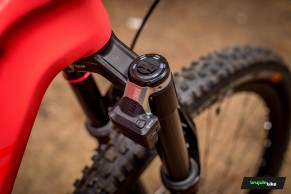
In the shock absorber there is another similar battery that provides an autonomy of 30 to 40 hours. In the control there is a 2032 battery whose autonomy can exceed two years and in the crank sensor there is a battery that will also operate for months.
So how does it work? Well, the system has three sensors in the fork, shock and crankset to detect any impact, whether slight or pronounced, at the same time as it detects the movement of the crankset. In this way it anticipates the perfect setting for the conditions of the terrain and the rider.
As long as we have the system in automatic mode, which we can check by seeing that the LED on the control module lights up green, the system alternates between three compression positions, which are open, pedal and lock, both in the fork and shock absorber, and not always both suspensions are in the same position, since depending on what the algorithm decides according to the data obtained by the sensors, the fork may have a lower level of compression than the shock absorber.
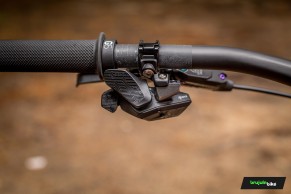
The Flight Attendant system thinks for us, but as not all riders have the same preferences, we can adapt it to our liking by means of the BIAS Adjust, or bias adjustment, which we can modify from the buttons on the main module or from the AXS App.
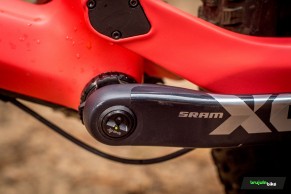
This setting consists of five positions, the standard setting is in the middle position and can be varied in 1 or 2 steps towards the locking or open position. In this way we favour the suspensions to have more tendency to lock or vice versa.
Another adjustment that we will have to make electronically, either from the buttons on the fork or from the app, is the LSC low speed compression adjustment, both for the fork and the shock absorber. Each suspension has ten LSC positions that are shown to us as the LEDs light up, which are blue when we are adjusting the fork and cyan when it comes to adjusting the shock absorber.

These adjustments are very easy to make, just pressing the menu button on the fork will show us the bias adjustment, lighting the led in magenta, with another press we go to the blue LSC adjustment of the fork, and if we press again we will see the cyan LEDs corresponding to the LSC of the rear. You can also do the same from the app in a very intuitive way.
If for any reason we want to put the system in manual mode, for example to adjust the sag, we leave the menu button pressed and the red LED will light up, indicating this mode, from which we can change the positions with the + and - buttons on the fork or with the AXS remote control if we have one.
In addition, by pressing and holding the AXS control, we can activate the Override Mode, which is a preferred setting position that we assign via the app so that, in any situation we want, the bike enters this mode. When Override Mode is activated, the orange LED lights up in the position you have chosen. Press the control again to return to Auto mode.

The system also has a safe mode which is activated when one of the batteries runs out of power. In safe mode, the suspensions remain open and the LEDs light up yellow.
The Flight Attendant electronics affect only the hydraulic part of the compression, so the sag is adjusted as in any suspension (setting the system in manual and open mode), and the rebound has its manual adjustment dial, as in any fork and shock absorber.
Contact and test drive of the Rock Shox Fligth Attendant
For our tests we received a brand new Canyon Neuron CF SLX LTD, the top of the range assembly of this trail model. And of course it is equipped with the complete AXS system, including drivetrain, dropper seat post and Flight Attendant suspension.
At the front is a Rock Shox Pike Ultimate Flight Attendant fork and Super Deluxe Flight Attendant shock, accompanied by Sram X01 cranks with the corresponding sensor to complete the system.
The first thing we did was to charge the AXS fork and shock absorber batteries, as both the controller and the crank sensor have a different type of battery with a very long life.
Then you have to activate the pedal sensor by pressing its button for 5 seconds, until the LED lights up.
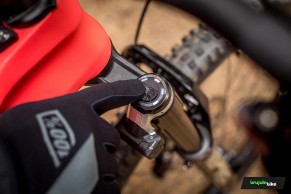
Once this is done, we proceed to pair the components, which is very simple. Press and hold the AXS button on the fork until the LED flashes slowly, then press and hold the AXS button on each component until each LED flashes rapidly. Then another short press on the main module of the fork and the system will be correctly paired.
In the app we can check that the operation has been done correctly if all the components appear below the main module.
It is worth mentioning the detail that the system does not have a power button or anything like that, but with a slight movement of the bike it is activated and after a rest period it switches off to avoid wasting battery power.
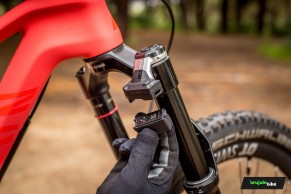
Once everything is paired up, it's time to adjust the sag, for this we select the manual mode in the Open position, and we proceed as in any other suspension, adjusting the pressure with our pump.
Then you have to calibrate the system with a few simple steps that are very well explained both in the manual and in the app. Once the calibration has been done correctly, we can use the automatic mode.
Once we had made an initial adjustment to the rebound and LSC compression of both suspensions (as mentioned above) we set off to test the system.
Flight Attendant in operation
The first kilometres with the system were really impressive and curious. It seems like magic how the bike is reading, and at times it even seemed to us that it was anticipating what was to come. The Flight Attendant takes readings every 5 milliseconds.
This does not mean that the suspensions lock and unlock many times per second, they simply read all the parameters provided by the sensors at high speed to decide the best settings at any given moment.
At each setting change there is a slight noise emitted by the electric motors, very similar to those produced by an AXS gearbox.

We say that the first kilometres were curious because we couldn't avoid looking at the fork module to see what the system was doing. At every moment we heard the little noise and inevitably our gaze was directed to the LEDs. This can be dangerous, as the LEDs light up intermittently, so we couldn't always see them at first glance.
This only happened to us on the first ride, or rather, until we started to fully trust the system and started to concentrate on guiding the bike through the trails, putting our attention on everything else and forgetting about the suspensions.
To avoid the temptation to look we have the option to set the system to dark mode via the app and only one LED lights up briefly at each change of position.
The three operating positions are quite similar to those we find when we have three-position levers. The shock absorber in Pedal mode notably reduces the oscillations of pedalling while retaining some absorption that gives us excellent traction on bumpy climbs. The lockout is quite firm, only yielding slightly in impacts or very strong impacts, we understand that to protect gaskets and seals of the shock absorber.
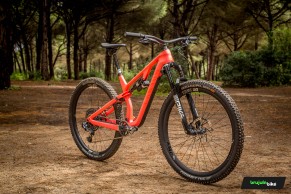
In the fork we noticed a little less differentiated the various positions, the locking being much less firm than in the rear, but enough to minimise the movement when pedalling.
Once adapted to the system, which only requires the effort to start trusting and forgetting about the LEDs, we did different tests with the BIAS adjust, taking it to one extreme to the other. There is a clear difference in the unlocking tendency if we set it to -2. The suspensions stay open longer when the terrain is uneven, but they also change mode if the bumps are over, although with minor impacts, especially if we stop pedalling, the suspensions open again.
On the other hand, at the +2 setting, the system is more prone to pedal mode and locking.
After our tests we decided that at the intermediate setting there is a fairly perfect balance.
Since we had the mission to test the system, we tried to put some "trap" to see if we could find the fault, and the truth is that it was impossible.
We found a step of a certain height on a smooth terrain where we were pedalling with the suspensions locked, because before reaching the ground they had already been unlocked to absorb the reception.

It became clear to us that the Flight Attendant comes to the market with a lot of development work behind it and is really fine-tuned.
In our ventures into enduro terrain, despite having a more versatile Trail bike, we could see that the performance of the suspension is excellent and the fact of having the Flight Attendant does not mean at all any reduction in the gross absorption capacity of the suspensions. Whenever the terrain demands it, the suspensions work at full capacity even if we have the most closed bias setting.
In addition, the possibility of adjusting the compression on the low setting allows us to find the perfect balance between sensitivity and support in braking and weight changes.
Conclusions about Rock Shox's electronic revolution
After spending some time enjoying the Flight Attendant, its benefits have become more than clear to us and we haven't found any drawbacks beyond the slight increase in weight that it may entail.
We have not found any sense in putting the system in manual mode (except for pressure and sag adjustment), so we think that our opinion is clear.
Even the override mode option is also dispensable. We can only think of situations like a sprint where you want to make sure you're locked, but on Trail or Enduro bikes it's unusual.
And what is the main advantage? Well, the first thing anyone would think is that you don't have to take your hand off the handlebars if you don't have a remote lock, or that you don't have to think about pressing the lock. And yes, these are advantages, but there are many more.
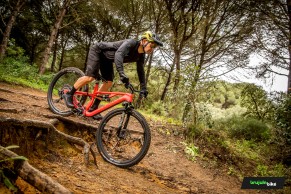
The first thing we would highlight is that it makes the bike much more efficient, as the Flight Attendant does not rest and, even in a very specific situation, the system will change the setting if necessary, no matter how little advantage is going to be gained. If we had to do it manually, we wouldn't be thinking every second about whether or not to touch the suspension.
Another advantage we find is that, on downhill trails, and even more so if we go with a knife between our teeth, there are sometimes small stretches of pedalling in which we don't usually think about blocking because we are doing something else, but with this system the bike is autonomous and will do it for you, helping you to be faster.
There is also another situation, which happens to more or less everyone from time to time, especially if we are absent-minded, and that is forgetting to unlock the suspension after a long uphill ride and entering a steep trail at speed and locked. Well, with Flight Attendant that won't happen any more. So if you're a bit absent-minded this is for you (if you don't forget to charge the batteries every so often).
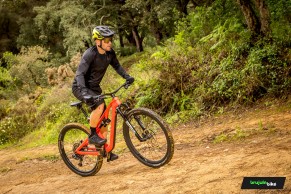
In short, it seems to us that the Rock Shox Flight Attendant takes bikes to the next level, clearly improving the efficiency of the suspension in exchange for just a few extra grams and taking into account that we will have to charge the battery of the main module and the shock absorber from time to time, and replace the battery of the control and crank sensor every few months.
Having seen how well the system works, we believe that it is only a matter of time before it reaches the rest of the modalities such as Cross Country or Marathon.
We have entered an electronic age that seems to have no end, and if it is going to bring us things as interesting as Flight Attendant, then so be it.





